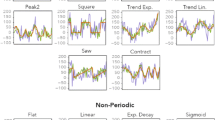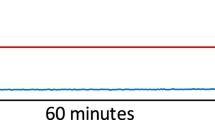Abstract
The short time series expression miner by Ernst et al. (Bioinformatics 21:i159–i168, 2005) assigns time series data to the closest of suitably selected prototypes followed by the selection of significant clusters and eventual grouping. We prove that the proposed dissimilarity measure 1 − ρ, with correlation coefficient ρ, can be interpreted as the distance of projected data onto the (d − 1)-dimensional unit sphere \({\mathcal{S}^{d-1}}\). The choice of prototypes is closely related to classical problems in optimization theory. Moreover, we propose a new functional, which has a data-driven component and connects the choice of prototypes to the theory of finite unit norm tight frames by Benedetto and Fickus (Adv Comput Math 18:357–385, 2003).
Similar content being viewed by others
References
Batchelor BG, Wilkins BR (1969) Method for location of clusters of patterns to initialise a learning machine. Electron Lett 5(20): 481–483
Belkin M, Niyogi P (2003) Laplacian eigenmaps for dimensionality reduction and data representation. Neurol Comput 15(6): 1373–1396
Benedetto JJ, Fickus M (2003) Finite normalized tight frames. Adv Comput Math 18: 357–385
Benedetto JJ, Czaja W, Ehler M (2010) Frame potential classification algorithm for retinal data. In: Herold KE, Bentley WE, Vossoughi J (eds) IFMBE proc series 32. Springer Intern Fed for Medical & Biological Engineering: 26th Southern Biomedical Engineering Conference, College Park, Maryland, USA, pp 496–499
Conway JH, Sloane NJA (1993) Sphere packings, lattices and groups. Springer, New York
Czaja W, Ehler M (2011) Schroedinger eigenmaps for the analysis of bio-medical data. arXiv:1102.4086v1
Daubechies I (1992) Ten lectures on wavelets. SIAM, Philadelphia
Duffin RJ, Schaeffer AC (1952) A class of non-harmonic fourier series. Trans Am Math Soc 72: 341–366
Ehler M (2011) Random tight frames. J Fourier Anal Appl (to appear). arXiv:1102.4080v2
Ehler M, Galanis J (2011) Frame theory in directional statistics. Stat Probab Lett 81: 1046–1051
Ehler M, Okoudjou KA (2011) Minimization of the probabilistic p-frame potential. arXiv:1101.0140v2
Ehler M, Rajapakse VN, Zeeberg B, Brooks B, Brown J, Czaja W, Bonner RF (2011) Nonlinear gene cluster analysis with labeling for microarray gene expression data in organ development. BMC Proc 5(Suppl 2): S3
Ernst J, Nau GJ, Bar-Joseph Z (2005) Clustering short time series gene expression data. Bioinformatics 21: i159–i168
Gasch AP, Spellman PT, Kao CM, Carmel-Harel O, Eisen MB, Storz G, Botstein D, Brown PO (2000) Genomic expression programs in the response of yeast cells to environmental changes. Mol Biol Cell 11: 4241–4257
Goyal V, Vetterli M, Thao NT (1998) Quantized overcomplete expansions in \({\mathbb{R}^n}\) : analysis, synthesis and algorithms. IEEE Trans Inf Theory 44: 16–31
Hastie T, Tibshirani R, Friedman J (2001) The elements of statistical learning. Springer, New York
Kim J, Kim JH (2007) Difference-based clustering of short time-course microarray data with replicates. BMC Bioinformatics 8: 253–264
Kovačević J, Chebira A (2007a) Life beyond bases: the advent of frames: part 1. IEEE SP Mag 24(4): 86–104
Kovačević J, Chebira A (2007b) Life beyond bases: the advent of frames: part 2. IEEE SP Mag. 24(5): 115–125
Qu Y, Bao-Ling A, Thornquist M, Potter JD, Thompson ML, Yasui Y, Davis J, Schellhammer PF, Cazares L, Clements MA, Feng Z (2003) Data reduction using a discrete wavelet transform in discriminant analysis of very high dimensionality data. Biometrics 59: 143–151
Saff E, Kuijlaars ABJ (1997) Distributing many points on a sphere. Math Intell 19: 5–11
Tammes PML (1930) On the origin of number and arrangement of the places of exit on pollen grains. PhD thesis, University of Groningen
Thomson JJ (1904) On the structure of the atom: an investigation of the stability and periods of oscillation of a number of corpuscles arranged at equal intervals around the circumference of a circle; with application of the results to the theory of atomic structure. Philos Mag Ser 6:7(39):237–265
Vlachos M, Lin J, Keogh E, Gunopulos D (2003) A wavelet-based anytime algorithm for k-means clustering of time series. In: Proceedings workshop on clustering high dimensionality data and its applications, pp 23–30
Author information
Authors and Affiliations
Corresponding author
Rights and permissions
About this article
Cite this article
Springer, T., Ickstadt, K. & Stöckler, J. Frame potential minimization for clustering short time series. Adv Data Anal Classif 5, 341–355 (2011). https://doi.org/10.1007/s11634-011-0097-4
Received:
Revised:
Accepted:
Published:
Issue Date:
DOI: https://doi.org/10.1007/s11634-011-0097-4




